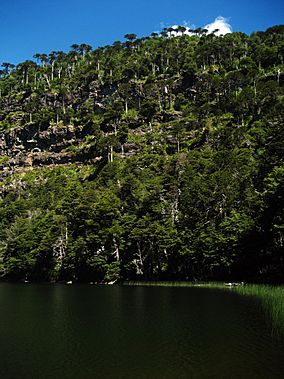Tolhuaca National Park facts for kids
Quick facts for kids Tolhuaca National Park |
|
|---|---|
|
IUCN Category II (National Park)
|
|

Laguna Verde
|
|
| Location | La Araucanía Region, Chile |
| Nearest city | Curacautín |
| Area | 6.474 ha |
| Established | 1935 |
| Governing body | Corporación Nacional Forestal |
Tolhuaca National Park is a special place in Chile that helps protect nature. It was created on October 16, 1935. The park started with about 3,500 hectares of land. This land used to be part of the Malleco National Reserve.
In 1985, more land from the Malleco National Reserve was added to the park. The Malleco National Reserve was actually the very first protected wildlife area in both Chile and all of South America. This means Tolhuaca National Park is one of the oldest protected areas on the whole continent!
Contents
Where is Tolhuaca National Park?
The park is located in a town called Curacautín. This town is in the Malleco area, which is part of the La Araucanía Region in southern Chile.
The park sits on the lower parts of the Andes mountains. These areas are covered in forests. Right next to the park, to the north, is the Malleco National Reserve.
The park is quite high up, from about 700 to 1,821 meters (2,300 to 5,974 feet) above sea level. It has small lakes and many ponds. Two of the lakes are called Laguna Malleco and Laguna Verde. The Malleco River also starts its journey inside the park. The amazing Tolhuaca volcano is very close to the park. You can see it from many spots inside the park.
How to Visit and What to See
There are two main ways to get to Tolhuaca National Park.
- The first way is from the town of Victoria. You take "Inspector Fernandes Road" for about 74 kilometers (46 miles).
- The second way is from Curacautín. You drive 34 kilometers (21 miles) on the road that goes towards the Tolhuaca Hot Springs.
Fun Things to Do and See
The park has many cool things to explore. You can see different kinds of plants and animals. The views of the Tolhuaca volcano are also amazing. There are many trails for hiking.
The park has a helpful information center. Park rangers are also there to help you. You can also find picnic areas to enjoy a meal outdoors.
There are four marked trails for hiking:
- The Chilpa trail
- The La Culebra–Lago Verde trail
- The Lagunillas trail
- The Salto Malleco trail
What is the Weather Like?
The weather in Tolhuaca National Park changes depending on where you are. It can be cold in the highest parts of the park. In the valleys, the weather is more moderate. It can rain at any time of the year. The temperature also changes a lot between day and night.
Amazing Plants of the Park
The higher areas of the park are home to some special trees:
- Nothofagus dombeyi, also known as the coihue or coigue. This name comes from the Mapuche language.
- Nothofagus pumilio, or lenga beech. This is a tree or bush that loses its leaves in the fall.
- Nothofagus obliqua, also called Patagonian oak, roble, or roble beech.
- Araucaria araucana, known as the monkey puzzle tree, Chilean pine, or pehuén. These trees often have lichen growing on them.
- Tolhuaca National Park Flora
-
Araucaria, known as monkey puzzle tree
Animals of Tolhuaca National Park
The park is a great place for many kinds of birds. Some birds live there all the time, and others visit the lakes. The CONAF (Chilean Forestry Commission) checks Malleco Lake every month. They count the birds that visit, live, and have their babies there. This helps them know which bird species need protection.
Bird Species and Their Life Cycle
Some of the birds you might see in the park include:
- Andean gull (Chroicocephalus serranus): This is a type of gull.
- Yellow-billed teal (Anas flavirostris)
- Rosy-billed pochard (Netta peposaca): Its Latin name means "duck with showy wings." These ducks have a bright white stripe on their wings that you can see when they fly.
- Lake duck (Oxyura vittata)
- Chimango caracara (Milvago chimango): This is a bird of prey, like a Peregrine falcon. People in Chile call it the tiuque.
- Buff-necked ibis (Theristicus caudatus): Also known as the white-throated ibis or bandurria.
- Andean condor: A very large bird.
- Ringed kingfisher (Megaceryle torquata): You can find these birds in wooded areas.
- Magellanic woodpecker (Campephilus magellanicus): Also found in wooded areas.
Mammals and Other Animals
The park is also home to many mammals:
- Cougar (Puma concolor)
- Coypu (Myocastor coypus): Also called a river rat or nutria.
- South American gray fox (Lycalopex griseus)
- Kodkod or güiña (Leopardus guigna)
There's even a special frog called Alsodes igneus that lives only in Tolhuaca National Park!
In the wooded parts of the park, you might find the rare pudú (Pudu puda). This is a very small type of deer. You might also see the monito del monte (Dromiciops gliroides). Its Spanish name means "little bush monkey." It's also called chumaihuén in the Mapudungun language. The monito del monte is a tiny marsupial that lives only in southwestern South America.
- Tolhuaca National Park Fauna
-
Kodkod or güiña (Leopardus guigna)
-
Magellanic woodpecker (Campephilus magellanicus).
-
Andean condor
See also
 In Spanish: Parque nacional Tolhuaca para niños
In Spanish: Parque nacional Tolhuaca para niños
- CONAF











